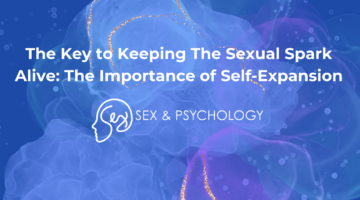Where Do Our Sexual Attractions Come From?
August 5, 2019 by Justin Lehmiller
Why are we sexually attracted to some people, but not others? Where do our attractions come from in the first place?
As a social psychologist who has studied issues of attraction extensively, I’ve learned that attraction is a very complex process. As I discuss in my book The Psychology of Human Sexuality, attraction is influenced by a wide range of biological, psychological, and social/environmental/cultural factors. For example:
On the biological side, our level of physiological arousal when we meet someone new can influence whether or not we find them attractive. How so? When we’re in a high-arousal state in which our hearts are racing and there are competing explanations present that arousal (e.g., meeting a sexy stranger versus having just finished a high-intensity workout), it appears that we often mistakenly attribute our arousal to the person instead of to the situation (read more about this idea here).
On the psychological side, we tend to be drawn to partners who are similar to us because being around similar people is validating and comforting—it makes us feel good (read more about the role of similarity in attraction here). Likewise, our mood state when we meet someone new can influence whether or not we develop an attraction to them. For instance, if you meet someone when you’re already feeling good (perhaps because you just got some great news at work), odds are that you’ll like them more, even though they have absolutely nothing to do with your current positive mood.
On the social/environmental side, the situation we’re in can influence who we find attractive. For example, research has found that people rate other patrons in a bar as more attractive when the bar is about to close compared to when it’s earlier in the evening—the “closing time effect,” as it’s known. I know what you’re thinking, and this isn’t just about alcohol consumption—it’s about the illusion of scarcity and shifting comparison levels (read more about this research here).
Likewise, there are also cultural factors involved in attraction. People tend to be drawn to what their culture or society holds to be beautiful or sexy. For example, in Western cultures, thinness is preferred in women; by contrast, fatter women are more desired in many non-Western cultures [1]. Cultural factors can also influence things like the race and ethnicity of the partners we’re attracted to as well (read more about this idea here).
These are just a few of the many, many factors involved in sexual attraction—and when you start to look at them in their entirety, you can begin to appreciate how attraction is a process that we don’t really control.
Our attractions are subtly shaped by numerous factors, which culminate in us developing “types.” In other words, at some point, we begin to go for partners with similar traits and characteristics (both physical and psychological) over and over. Research suggests that, whether we consciously recognize it or not, most people do indeed tend to have “types” when it comes to sex and love [2,3].
Our “types” are shaped through learning and experience. You can think of this as an operant conditioning process, which, incidentally, is also the process through which a lot of fetishes are formed. The basic idea is that we want to repeat experiences for which we have received rewards or positive reinforcement—and, conversely, we want to avoid experiences that were negatively reinforced or punished.
So, for example, if you had a partner with a certain set of physical traits (e.g., tall, dark, and handsome) and you happened to have really good sex with that person, this could be considered a form of positive reinforcement that may lead you to be drawn to partners with similar traits in the future because your brain has come to associate those traits with pleasure and enjoyment.
When you consider all of the factors that go into attraction, it shouldn’t be surprising to learn that people don’t seem to know what it is that they want. In fact, some research has found that what people say they want in a partner doesn’t match up with the traits of the partners they actually go for. This makes sense because, when we complete surveys about what it is that we’re attracted to in a calm, cool, and collected state, we can’t take into account how factors like our physiological arousal, mood, or time of day might influence how we feel about a given individual.
Want to learn more about Sex and Psychology ? Click here for previous articles or follow the blog on Facebook (facebook.com/psychologyofsex), Twitter (@JustinLehmiller), or Reddit (reddit.com/r/psychologyofsex) to receive updates. You can also follow Dr. Lehmiller on YouTube and Instagram.
[1] Gray, P. B., & Frederick, D. A. (2012). Body image and body type preferences in St. Kitts, Caribbean: A cross-cultural comparison with US samples regarding attitudes towards muscularity, body fat, and breast size. Evolutionary Psychology, 10(3), 147470491201000319.
[2] Eastwick, P. W., Harden, K. P., Shukusky, J. A., Morgan, T. A., & Joel, S. (2017). Consistency and inconsistency among romantic partners over time. Journal of Personality and Social Psychology, 112(6), 838.
[3] Park, Y., & MacDonald, G. (2019). Consistency between individuals’ past and current romantic partners’ own reports of their personalities. Proceedings of the National Academy of Sciences, 116(26), 12793-12797.
Image Source: 123RF/Andrea De Martin
You Might Also Like:

Dr. Justin Lehmiller
Founder & Owner of Sex and PsychologyDr. Justin Lehmiller is a social psychologist and Research Fellow at The Kinsey Institute. He runs the Sex and Psychology blog and podcast and is author of the popular book Tell Me What You Want. Dr. Lehmiller is an award-winning educator, and a prolific researcher who has published more than 50 academic works.
Read full bio >


